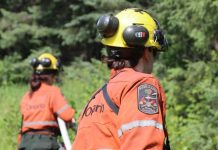Thunder Bay – NEWS – Details of the proposed lockdown in Ontario to stem the surge of COVID-19 are being revealed by sources. What it looks like for Thunder Bay and the rest of Western and Northern Ontario will be a 14-day lockdown. The lockdown will also mean students will wait at least a week longer before returning to classes in January.
It is not known yet is the Algoma District which has been in the Green zone will be impacted but it is expected the same 14 day lockdown will be imposed.
The lockdown will start 12:01 am EST on Boxing Day, December 26, 2020, and will extend for 28 days in Southern Ontario, and for 14 days in regions of Ontario North and West of Sudbury.
The lockdown will be similar to the lockdown earlier in the year when only essential businesses and services would be allowed to open.
Here is the list of Essential Services from April 2020
Businesses that are not identified on this list must close their physical locations.
Supply chains
- Businesses that supply other essential businesses or essential services within Ontario, or that supply business or services that have been declared essential in a jurisdiction outside of Ontario, with the support, products, supplies, systems, or services, including processing, packaging, warehousing, distribution, delivery, and maintenance necessary to operate.
Food
- Businesses that primarily sell food, beverages and consumer products necessary to maintain households and businesses including:
- Supermarkets and grocery stores.
- Convenience stores.
- Discount and big-box retailers selling groceries.
- Restaurants (take-out, drive-through and delivery service only).
- Beer and wine and liquor stores.
Services
- Pharmacies.
- Gas stations and other fuel suppliers.
- Laundromats and drycleaners.
- Security services for residences, businesses and other properties.
- Vehicle and equipment repair and essential maintenance and vehicle and equipment rental services.
- Courier, postal, shipping, moving and delivery services.
- Funeral and related services.
- Staffing services including providing temporary help.
- Veterinary services (urgent care only) and other businesses that provide for the health and welfare of animals, including farms, boarding kennels, stables, animal shelters, zoos, aquariums and research facilities.
- Home child care services of up to six children as permitted under the Child Care and Early Years Act, 2014, and child care centres for essential workers authorized to operate in accordance with Ontario Regulation 51/20 (Order Under Subsection 7.0.2 (4) of the Act – Closure of Establishments) made under the Act.
- Hotels, motels, other shared rental accommodation including student residences, except for seasonal campgrounds and any pools, fitness centres, meeting rooms and other recreational facilities that may be part of the operations of these businesses.
- Cheque cashing services.
Services to the public that are restricted to alternative methods of sale
- Stores that sell any of the following items and provide them to the customer only through an alternative method of sale such as curb side pick-up or delivery, except in exceptional circumstances:
- Hardware products.
- Vehicle parts and supplies.
- Pet and animal supplies.
- Office supplies and computer products including computer repair.
- Safety supplies.
Financial services
- Businesses that provide the following financial services:
- Capital markets and related securities trading and advisory services.
- Banking/credit union activities including credit intermediation.
- Insurance.
- Land registration services.
- Real estate agent services.
- Pension and benefits payment services.
- Financial services including payroll and payment processing and accounting and tax services.
Telecommunications and IT infrastructure/service providers
- Information Technology (IT) services, including online services, software products and the facilities necessary for their operation and delivery.
- Telecommunications providers and services (phone, internet, radio, cell phones etc.) and facilities necessary for their operation and delivery.
- Newspapers, radio and television broadcasting.
Maintenance
- Maintenance, repair and property management services strictly necessary to manage and maintain the safety, security, sanitation and essential operation of institutional, commercial, industrial and residential properties and buildings.
Transportation services
- Businesses and facilities that provide transportation services, including,
- transportation services provided by air, water, road, and rail, including taxis and other private transportation providers, and
- support services for transportation services, including,
- logistical support, distribution services, warehousing and storage, truck stops and tow operators,
- services that support the operations and safety of transportation systems including maintenance and repairs, and
- marinas, but only to the extent that the marina is necessary to enable individuals to access their primary place of residence.
- Businesses that provide and support online retail, including by providing warehousing, storage and distribution of goods that are ordered online.
Manufacturing
- Businesses that extract, manufacture, process and distribute goods, products, equipment and materials, including businesses that manufacture inputs to other manufacturers, (e.g. primary metal/ steel, blow molding, component manufacturers, chemicals, etc. that feed the end-product manufacturer), regardless of whether those other manufacturers are inside or outside of Ontario, together with businesses that support and facilitate the movement of goods within integrated North American and global supply chains.
Agriculture and food production
- Businesses that produce food and beverages, and agricultural products including plants, including by farming, harvesting, aquaculture, hunting and fishing.
- Businesses that process, manufacture or distribute food, beverages, crops, agricultural products, animal products and by-products.
- Businesses that support the food or agricultural products supply chains and the health and safety of food, animals and plants.
Construction
- Construction projects and services associated with the healthcare sector, including new facilities, expansions, renovations and conversion of spaces that could be repurposed for health care space.
- Construction projects and services required to ensure safe and reliable operations of, or to provide new capacity in, critical provincial infrastructure, including transit, transportation, energy and justice sectors beyond the day-to-day maintenance.
- Critical industrial construction activities required for,
- the maintenance and operations of petrochemical plants and refineries,
- significant industrial petrochemical projects where preliminary work has already commenced,
- industrial construction and modifications to existing industrial structures limited solely to work necessary for the production, maintenance, and/or enhancement of Personal Protective Equipment, medical devices (such as ventilators), and other identified products directly related to combatting the COVID-19 pandemic.
- Residential construction projects where,
- a footing permit has been granted for single family, semi-detached and townhomes
- an above grade structural permit has been granted for condominiums, mixed use and other buildings, or
- the project involves renovations to residential properties and construction work was started before April 4, 2020.
- Construction and maintenance activities necessary to temporarily close construction sites that have paused or are not active and to ensure ongoing public safety.
Resources and energy
- Businesses that provide and ensure the domestic and global continuity of supply of resources, including mining, forestry, aggregates, petroleum, petroleum by-products and chemicals.
- Electricity generation, transmission, distribution and storage and natural gas distribution, transmission and storage.
Community services
- Businesses that deliver or support the delivery of services including:
- Sewage treatment and disposal.
- Collecting, transporting, storing, processing, disposing or recycling of any type of waste.
- Potable drinking water.
- Critical infrastructure repair and maintenance including roads, dams, bridges etc.
- Environmental rehabilitation, management and monitoring, and spill clean up and response.
- Administrative authorities that regulate and inspect businesses.
- Professional and social services that support the legal and justice system.
- Government services including but not limited to policing and law enforcement, fire and emergency services, paramedics, coroner and pathology services, corrections and court services, licences and permits.
Research
- Businesses and organizations that maintain research facilities and engage in research, including medical research and other research and development activities.
Health care and social services
- Organizations and providers that deliver home care services or personal support services to seniors and persons with disabilities.
- Businesses that sell, rent or repair assistive/mobility/medical devices, aids and/or supplies.
- Regulated health professionals (urgent care only) including dentists, optometrists, chiropractic services, ophthalmologists, physical and occupational therapists and podiatrists.
- Organizations that provide health care including retirement homes, hospitals, clinics, long-term care facilities, independent health facilities and mental health and addictions counselling supports.
- Laboratories and specimen collection centres.
- Manufacturers, wholesalers, distributors and retailers of pharmaceutical products and medical supplies, including medications, medical isotopes, vaccines and antivirals, medical devices and medical supplies.
- Manufacturers, distributors and businesses that provide logistical support of or for products and/or services that support the delivery of health care in all locations.
- Not-for-profit organizations that provide critical personal support services in home or residential services for individuals with physical disabilities.
- Not-for profit organizations that support the provision of food, shelter, safety or protection, and/or social services and other necessities of life to economically disadvantaged and other vulnerable individuals.
There is no word on any provincial supports being prepared for small businesses which would be required to close.
The move to a lockdown is supported by the Ontario Hospital Association. In a statement, “Ontario’s hospitals take enormous pride in the role they play providing high-quality health services to the people of Ontario every day. During the COVID-19 pandemic, they have stepped up to take on additional roles and expanded services by supporting assessment centres and lab testing, assisting in long-term care homes, conducting research to better understand the virus, and increasing inpatient and critical care capacity. Now, thanks to the hard work and planning of the federal and provincial governments, hospitals will also play an important role alongside public health in the distribution of COVID-19 vaccinations. As they keep up with current needs, hospitals are also working diligently to catch up on approximately 150,000 scheduled surgeries cancelled in the first wave of the pandemic. Evidence is mounting that the hidden toll on human health from this disruption in scheduled services will be heavy. Our communities are tired, and so are those caring for them.
“We cannot, however, avoid the reality. Ontario remains firmly caught in the grasp of a major second wave of COVID-19. Daily infection is now above 2,000 new cases per day. Hospitalization is increasing rapidly, as is the occupancy of intensive care units. A growing number of hospitals are grappling with outbreaks, and many have already had to cancel scheduled surgeries and other activity. Ontario’s health care professionals are being asked to carry a very heavy burden. The average length of stay of COVID-19 patients has decreased, but hospitals are seeing more of them, which is accelerating demands on health care workers. They are mentally, physically and emotionally exhausted, but because of their calling, they carry on.
“The situation is extremely serious. We are now in the holiday season and if members of the public choose to ignore public health measures and gather outside their households, the consequences risk overwhelming Ontario’s hospitals. Every health care system has its breaking point.
“That is why the Ontario Hospital Association is calling on the people of this province to remain steadfast in the fight against this pandemic. We are also recommending further decisive action by the Government of Ontario. We ask for understanding and support as we reluctantly and with deep regret recommend that as a minimum, the government implement and robustly enforce a four-week lockdown in every public health unit with an infection rate of 40/100,000 population or higher. This is in keeping with the criteria laid out in the government’s COVID-19 Response Framework, and is necessary to protect the health and safety of the people of Ontario and to ensure that hospitals do not face a devastating surge in COVID-19 patients requiring hospitalization and intensive care in January. In the remaining public health units, the government must give priority to the reproduction rate and test positivity trends, in addition to the infection rate, when determining whether additional public health measures may be required. Finally, we also recommend that the grey lockdown zone of the province’s framework be rapidly re-evaluated by independent public health and epidemiological experts to determine if additional, stricter provisions are necessary.”






